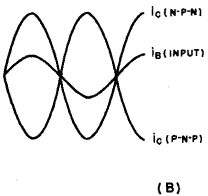|
Basic Theory
Author: Leonard Krugman

Fig. 5-21. (A) Composite characteristics for N-P-N and P-N-P transistors.
The circuits discussed to this point can be used with either N-P-N or P-N-P transistors. It is necessary only that the battery supply is connected with the proper polarity. For other applications, it is possible and often very profitable to combine the two types of junction transistors into one circuit.
This technique permits the design of many novel configurations that have no direct equivalent in vacuum tube circuits, since no one has yet invented a vacuum tube that emits positive particles from its cathode. Some of the characteristics of this unique property of transistors can be illustrated with the help of Fig. 5-21 (A), which is the composite curve of N-P-N and P-N-P units having identical characteristics except for polarity. (Practical circuits are never designed for an exact match, because of the expense of selection.) For each operating point E1I1 in the N-P-N unit, there is an equivalent operating point (-E1) (-I1) for the P-N-P unit These symmetrical properties offer innumerable possibilities in circuit applications. For example, if a peak signal current of 20 μa is applied to the base of each transistor simultaneously, the operating point of the N-P-N transistor has shifted to E2 = 8 volts, I2 = 15 ma at the instant that the input signal reaches a value of + 10 μa. But at the same instant the operating point of the P-N-P unit is at E2 = -22 volts, and I2 = -5 ma. An increase in the base current of the N-P-N unit causes the collector current to increase; the same variation causes the collector current of the P-N-P unit to decrease. When the signal is reversed, the opposite effect occurs. The complete waveforms for this operation are shown in Fig. 5-21 (B). Since the output of the transistors are 180° out of phase, it appears that the N-P-N and P-N-P types will operate, with their input circuits in parallel, as a push-pull stage. Furthermore, due to the complementary action of the N-P-N and P-N-P types, the circuit does not require an input transformer or a phase inverter.

Fig. 5-21. (B) Waveforms of composite characteristics.
|


 Transistor Amplifiers
Transistor Amplifiers  Complementary-Symmetry Circuits
Complementary-Symmetry Circuits  Basic Theory
Basic Theory





 Transistor Amplifiers
Transistor Amplifiers  Complementary-Symmetry Circuits
Complementary-Symmetry Circuits  Basic Theory
Basic Theory


